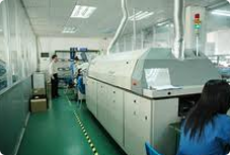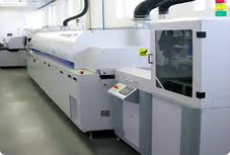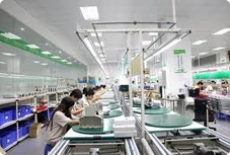electronic
-

Wave Soldering is a large-scale soldering process by which electronic components are soldered to a printed circuit board (PCB) to form an electronic assembly. The name is derived from the use of waves of molten solder to attach metal components to the PCB. The process uses a tank to hold a quantity of molten solder; the components are inserted into or placed on the PCB and the loaded PCB is passed across a pumped wave or waterfall of solder. The solder wets the exposed metallic areas of the board (those not protected with solder mask, a protective coating that prevents the solder from bridging between connections), creating a reliable mechanical and electrical connection. The process is much faster than manual soldering of components.
-

Surface-mount technology (SMT) is a method for constructing electronic circuits in which the components are mounted directly onto the surface ofprinted circuit boards (PCBs). An electronic device so made is called a surface-mount device (SMD). In the industry it has largely replaced thethrough-hole technology construction method of fitting components with wire leads into holes in the circuit board. Both technologies can be used on the same board for components not suited to surface mounting such as transformers and heat-sinked power semiconductors. An SMT component is usually smaller than its through-hole counterpart because it has either smaller leads or no leads at all. It may have short pins or leads of various styles, flat contacts, a matrix of solder balls (BGAs), or terminations on the body of the component.
-

An assembly line is a manufacturing process (most of the time called a progressive assembly) in which parts (usually interchangeable parts) are added to a product in a sequential manner to create a finished product much faster than with handcrafting-type methods. Assembly lines are designed for the sequential organization of workers, tools or machines, and parts. The motion of workers is minimized to the extent possible. All parts or assemblies are handled either by conveyors or motorized vehicles such as fork lifts, or gravity, with no manual trucking. Heavy lifting is done by machines such as overhead cranes or fork lifts. Each worker typically performs one simple operation.




